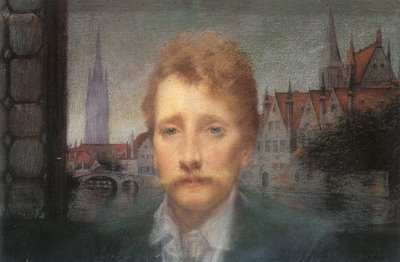
Bruges, Paris and the spectres of Symbolism
"What they were looking for can be seen in the famous portrait of the Belgian Symbolist painted by Lucien Lévy-Dhurmer in 1895, three years after the publication of Bruges-la-Morte, which is now in the Musée d’Orsay in Paris. It depicts Rodenbach in an open-necked white shirt, with a stylized Bruges behind him. There are gabled housefronts and a beguinhof on his left, a cathedral tower on his right, and, below it, a low stone bridge. His shoulders seem to merge with the canal at his back, and he looks thin and ghostly (he died three years later, in the same year as his friend and master, Mallarmé). Rodenbach appears as the city’s emanation, a pale flower from its watery depths; at the same time, Bruges is like a crepuscular think-bubble, existing only as the writer’s projection. The persistence of that image, or its persistent vagueness, is attested to by the fact that in the Pisan Cantos, meditating on the lost world of European Symbolism, Pound remembers, or half-remembers, “somebody’s portrait of Rodenbach”. If the Symbolist unconscious could be represented as a city, that city was Bruges..."